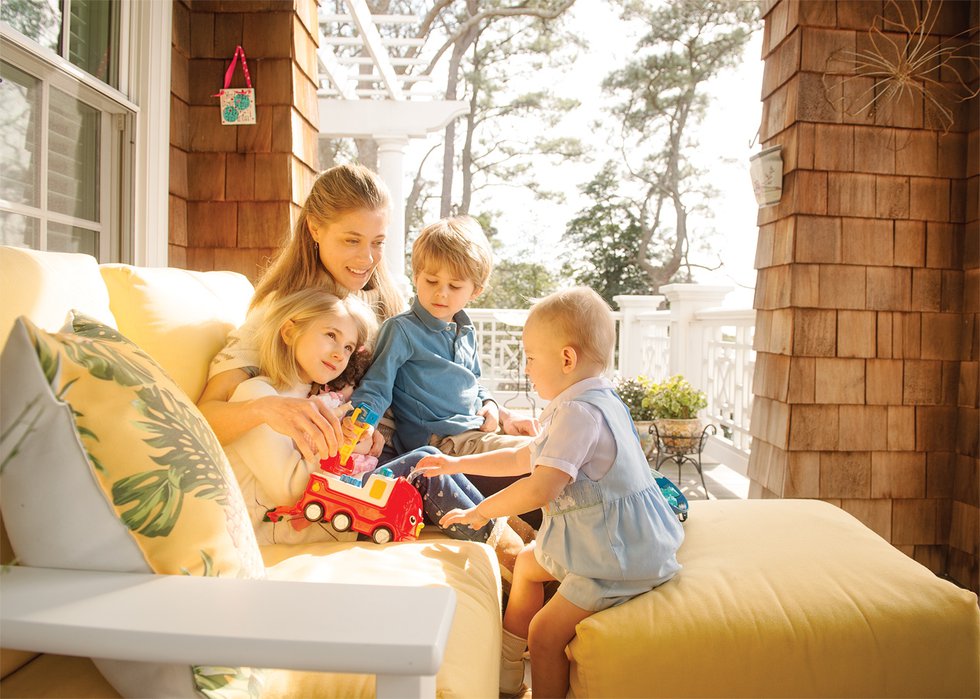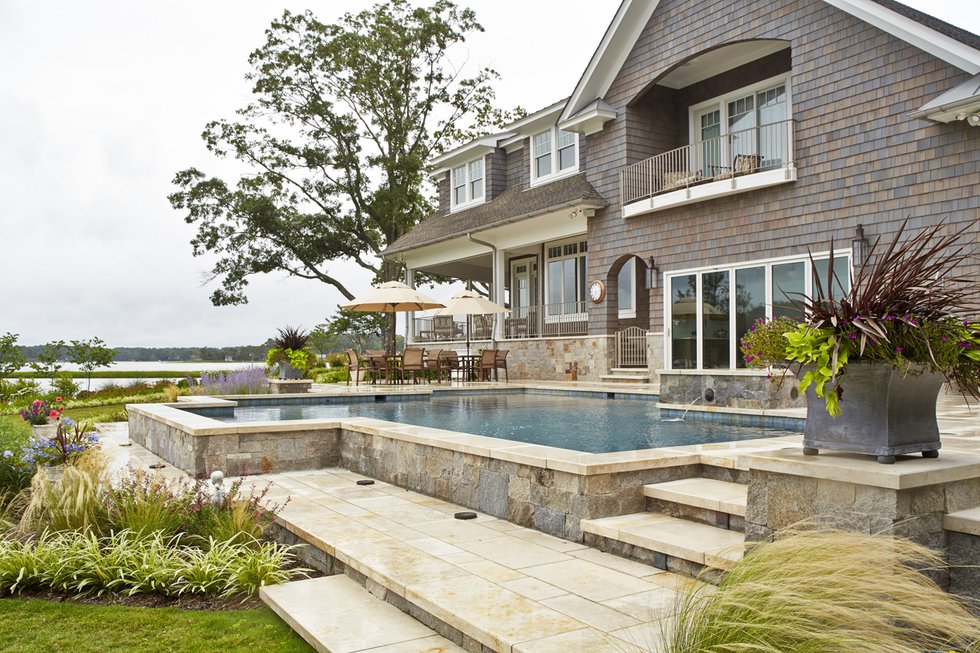Connie and Ed Kellam have transformed a historic Norfolk home and its forgotten garden into a gracious gathering place for their large family.

Ed and Connie Kellam with Colt, Win and Quinn.
Photos by Mark Edward Atkinson

An arrangement of roses, wisteria and fatsia complements the couple’s gold monogrammed Murano wine glasses, found on a visit to Venice.

Calla lilies, spray roses, hellebores, bog lily and variegated pittosporum in a vase on the breakfront from the 1800s.

A painting by Hermann Herzog hangs beside a Japanese arrangement of the three blessings of winter (pine, bamboo and flowering apricot).

Roses and ranunculus complement a framed silk scarf of St. Mark’s Square in Venice that hangs above the kitchen sideboard.

The staircase landing contains the home’s original arched window.

Quinn arranging flowers with Connie.

A spray, including quince, mahonia and delphinium in the sun room.

Grandchildren gather on the Red Porch, named so because of its red marble floor.

A vase of tulips on the dining room table.

The couple’s pug Charley sits on Quinn’s lap, with Marianne and Colt.

Ed and Connie Kellam
Most people downsize once their children are grown, but Connie and Ed Kellam found they needed the opposite. When they hosted their four children, spouses and grandchildren at their previous home in Virginia Beach, the couple was often forced to sleep at a nearby hotel. What the Kellams needed was more space.
So, in 2010, Ed and Connie, who both grew up in Norfolk but had raised their family near the beach, started looking for a larger house. What they found was a 1912 Dutch Colonial with cedar shingles and white trim in Norfolk’s Lochhaven neighborhood, facing the Lafayette River and the Naval Shipyard.
Connie, who managed an art gallery at Norfolk Academy, confesses she had been more inclined to stay at the beach, but Ed, who works in insurance, had grown up in Lochhaven and was eager to see the house. After she saw it, Connie says she changed her mind. It had obviously been a happy home, she explains, and she relished the relative quiet after years of living “under the jets” from Oceana Naval Air Station near their Birdneck Point neighborhood. It would work for their family.
But this would be a project with a capital P—a complete renovation that would delay their move-in day by three years. “My mother just thought we’d lost our minds,” Connie recalls, “because it was a mess. But Ed and I had a vision.”
That vision is now a reality: an elegant, light-filled home with an impressive collection of antique furniture, vintage light fixtures and paintings of children, soldiers, ships and landscapes. It features traditional and formal elements, but it’s meant for everyone, even the couple’s 8-year-old pug, Charlie.
Most importantly, it is large enough for the Kellams’ children and their families, including eight grandchildren, so they can all stay under one roof at the same time. “This house, I did for them,” says Connie. “I told them, ‘This is your house.’”
A Work in Progress
Before any other work could begin, the house had to be raised more than two feet to accommodate a new brick platform. Pipes and electrical wires were replaced, and the Kellams moved a historic carriage house on the property across the driveway to make room for parking. And then there were the interior cosmetic changes.
Facing such a daunting project, the Kellams asked their two then-single children to wait to get married so they could tackle the house renovation first. That didn’t work out, Connie says with a laugh. Both were engaged within three months, and work on the home was delayed for the next year.
After the weddings, the couple hired a family friend working at Norfolk commercial building contractor E.T. Gresham Company, and the project proceeded quickly. The job was more like a commercial restoration than a typical home renovation, the contractor told Ed.
“We had subcontractors here all the time,” Connie recalls. To keep everyone on track, she created a giant color-coded chart of every single job, their deadlines and the subcontractors’ phone numbers.
She didn’t hesitate to call when someone didn’t show up on time, because many tasks depended on the timely completion of other work.

Connie with grandson Win.
Photos by Mark Edward Atkinson

Ed and Win.

Alex, Colt, Parker, Natalie, Win, Quinn and Clay

Daughter-in-law Marianne Kellam with Quinn, Colt and Win on the master bedroom porch.
After a year and a half of construction, the home was ready for move-in on the first day of October 2013—a self-imposed deadline for the couple that turned out to be just nine days before their daughter had her first child.
The home opens to a goldenrod-hued foyer, lit by the first of several salvaged chandeliers and featuring a painting of Florence, Italy, by Norfolk artist Charles Sibley. A grand staircase leads to the second floor bedrooms: the grandsons’ room contains a well-used bunk bed and a signed photo of Hopalong Cassidy that belonged to Ed; the granddaughters’ room is painted a sweet petal pink; and two bedrooms for adults are fitted with classic four-poster beds. The master bedroom has a small sitting area and a wraparound porch with an expansive view of the water. A painting of Ed’s father in military uniform keeps watch over the landing at the top of the stairs.
It can still get crowded, but there is room for everyone, says Connie.
Downstairs, formal décor-—Ed’s taste—and traditional, but more casual décor—Connie’s—alternate by room. A light turquoise sunroom houses cushy sofas and chairs and a slightly worn Oriental rug their three boys used to wrestle on growing up.
Next door is the dressier living room, featuring a tall wood-and-glass secretary and a painting of a girl in a field by German-American artist Hermann Herzog. The couple inherited both pieces from Ed’s parents, but the Herzog painting has become Connie’s favorite.
Because Ed has a degree of colorblindness, many of the indoor hues are bright. Royal-blue walls with white crown molding set off floral-print settees and chairs in the living room, and the dining room walls are covered in a dramatic red-and-gold damask wallpaper that determined the rest of the room’s décor: a custom-built mahogany dinner table, a brass replica of a 16th-century Cellini shield mounted above a china press, and several pieces of silver service inherited from Connie’s mother.
The kitchen, where the family gathers during visits, is anchored by a long granite island with bar seating not far from the prep area and stove.
Next to the nearby mudroom, the Kellams have replicated a favorite New York City shop’s inventive wine storage system—bottles are placed in never-used clay sewer pipes and arranged in a geometrical pattern. On a nearby wall, a large poster rescued from an Italian opera house reminds Connie of a family trip to Milan in 1998.
In the study, a rich, wooden secretary and breakfront with delicate, carved detailing dominate one wall. A dedicated antiquer, Ed found the piece, which originates from England, c. 1880-1920, at Jere’s Antiques in Savannah, Georgia. It sat in his office for years, until it found a home here. Illuminating the room is a hefty brass swan-themed chandelier from Caravati’s Salvage in Richmond’s Manchester neighborhood.
“Negotiating with them on the price, that’s the fun of it for me,” says Ed. “I’m a horse-trader.”
A Discovery Outdoors
Early on in the renovation, Ed unearthed a brick wall next to the house, and he followed it to its end. Some research determined that the wall was part of an English-style garden unknown to the previous owners, who had lived in the home for 40 years. The garden likely dated to the home’s construction in 1912 by the Martin family of the now defunct Burrow-Martin Drug Company.

The English cutting garden consists of eight symmetrical gardens surrounded by a brick wall.
Photo by Mark Edward Atkinson
Connie, a master gardener who this year is chairman of the Garden Club of Norfolk’s Home & Garden Tour during Historic Garden Week, was delighted by the find. The couple decided to recreate the garden, unearthing its brick walls and building on top of them.
Now, they have eight symmetrical beds where Connie has planted many kinds of flowers for clipping. Most are perennials, chosen to prolong the blooming season, starting in early spring.
Just off the kitchen, Connie has a small flower room outfitted with a deep sink and counter to make floral arrangements, one of her passions. (Next year, the Kellams’ home will be on the Norfolk Home & Garden Tour.)
In addition to what Ed calls the English Garden, the Kellams’ property also includes a wooded area with a small trail and wooden bridge next to a playground for their grandchildren, who range in age from 1 to 11. When they purchased the land, the yard was mainly forest, but the Kellams wanted to be able to see their neighbors on either side, necessitating a heavy trim.
Between the small, gated pool and the river’s edge is a spread of cushiony zoysia grass, which grows well in spite of the Lafayette River’s brackish water. A white, cross-shaped marine flagpole flies a fish-shaped windsock. It’s one of Ed’s antiques coups; purchased at Aardvark Antiques in Rhode Island, the flagpole was a prop on the set of the whimsical 2012 film Moonrise Kingdom. Across the water is a small wooden pier in need of repair, a project on the list for later this year.
Just beyond the Kellams’ cove is the Norfolk Naval Shipyard, the oldest and largest in the country. Today, modern vessels pass through the same waterways where Christopher Newport sailed the Susan Constant in 1607, on his way to found Jamestown.
In late afternoon, the sun sparkles on the water in front of the Kellams’ home. This is one of Connie’s favorite things about where they live, the sun giving way to twilight.
“I love the piers,” she says. “They twinkle at night. This is what Norfolk is.”
Special thanks to the Garden Club of Norfolk and Harborfront Garden Club for creating floral arrangements. GCVirginia.com
Historic Garden Week 2017

View of the Kellams’ garden.
Photo by Mark Edward Atkinson
Featuring historic homes, gardens and other landmarks across the Commonwealth, Historic Garden Week takes place April 22-29. The Garden Clubs of Norfolk and Harborfront host their tour on the 27th in the eclectic Ghent area. It includes four homes, the Norfolk Botanical Garden and the Norfolk Woman’s Club. Connie Kellam, Norfolk tour chairman, calls it “a walk back in history.” The tour also will feature a collection of antique cars and a historic fire truck, as well as a wine-tasting event. Skip Stiles, executive director of Norfolk’s Wetlands Watch, will speak about flooding and its impact on the region.
Admission for the Norfolk tour is $30 in advance and $40 the day of the tour. For tickets and information about the more than 30 Historic Garden Week tours taking place all around the state, go to VAGardenWeek.org, or look for the special garden week tours map in our April issue.
This article originally appeared in our April 2017 issue.










